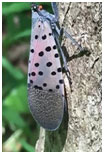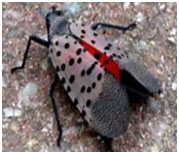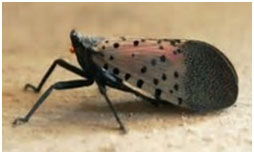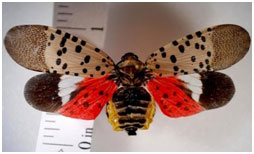Spotted Lanternfly
 There is a new invasive doing harm in the Adirondacks and elsewhere. While it may appear as a ‘pretty’ bug, it does devastating damage. New York State Department of Agriculture and Markets confirmed in November 2017 that the spotted lanternfly, an invasive insect, has been found in Delaware County, New York. This insect is native to Asia and has also been detected in Pennsylvania (in 2014) and Delaware (2017). The pest targets ailanthus trees, in particular, and attacks a wide variety of crops including grapes, hops, apples and forest products. There is a new invasive doing harm in the Adirondacks and elsewhere. While it may appear as a ‘pretty’ bug, it does devastating damage. New York State Department of Agriculture and Markets confirmed in November 2017 that the spotted lanternfly, an invasive insect, has been found in Delaware County, New York. This insect is native to Asia and has also been detected in Pennsylvania (in 2014) and Delaware (2017). The pest targets ailanthus trees, in particular, and attacks a wide variety of crops including grapes, hops, apples and forest products. The insect is easy to identify with distinct markings.It will change hosts as it goes through its developmental stages. Nymphs feed on a wide range of plant species (willow, maple, poplar, sycamore as well as fruit trees like plum, cherry, and peach) while adults prefer to feed and lay eggs on tree of heaven (A. altissima). The insect is easy to identify with distinct markings.It will change hosts as it goes through its developmental stages. Nymphs feed on a wide range of plant species (willow, maple, poplar, sycamore as well as fruit trees like plum, cherry, and peach) while adults prefer to feed and lay eggs on tree of heaven (A. altissima).If left unchecked, the spotted lanternfly can potentially wreak havoc on the New York’s grape, orchard and logging industries. It causes harm by sucking sap from plant stems and leaves. This can reduce photosynthesis, weaken the plant and eventually contribute to the plant’s death.  Invasive species can be transported to new locations in various ways. While the insect can walk, jump, or fly short distances, its long-distance spread is facilitated by people who move infested material or items containing egg masses. Spotted lanternflies are easiest to spot at dusk or at night as they migrate up and down the trunk of the plant. If you find an insect that you suspect is the spotted lanternfly, please take a specimen or a photo and contact our Extension offices to have its identity confirmed. Invasive species can be transported to new locations in various ways. While the insect can walk, jump, or fly short distances, its long-distance spread is facilitated by people who move infested material or items containing egg masses. Spotted lanternflies are easiest to spot at dusk or at night as they migrate up and down the trunk of the plant. If you find an insect that you suspect is the spotted lanternfly, please take a specimen or a photo and contact our Extension offices to have its identity confirmed. One way to prevent the spread of this insect within New York State is to limit the spread of Tree of Heaven which is also an invasive species. Young seedlings may be pulled or dug up, taking care to remove all roots and fragments, preferably when soil is moist. Chemical controls work best during late winter/early spring and in summer. The cut stump method is useful in areas where the trees need to be removed from the site and will be cut as part of the process. The hack-and-squirt or injection method is also effective and minimizes sprouting and suckering when applied during the summer. One way to prevent the spread of this insect within New York State is to limit the spread of Tree of Heaven which is also an invasive species. Young seedlings may be pulled or dug up, taking care to remove all roots and fragments, preferably when soil is moist. Chemical controls work best during late winter/early spring and in summer. The cut stump method is useful in areas where the trees need to be removed from the site and will be cut as part of the process. The hack-and-squirt or injection method is also effective and minimizes sprouting and suckering when applied during the summer.Additional Resources: USDA Fact Sheet: Spotted Lanternfly (Lycorma delicatula) NYS Department of Agriculture and Markets Confirms Finding of Spotted Lanternfly Invasive Insect USDA Animal and Plant Health Inspection Service: Spotted Lanternfly Contact Donna Peterson Program Educator, Community Horticulture dmp234@cornell.edu 518-828-3346 ext.106 |
|
|
 There is a new invasive doing harm in the Adirondacks and elsewhere. While it may appear as a ‘pretty’ bug, it does devastating damage. New York State Department of Agriculture and Markets confirmed in November 2017 that the spotted lanternfly, an invasive insect, has been found in Delaware County, New York. This insect is native to Asia and has also been detected in Pennsylvania (in 2014) and Delaware (2017). The pest targets ailanthus trees, in particular, and attacks a wide variety of crops including grapes, hops, apples and forest products. There is a new invasive doing harm in the Adirondacks and elsewhere. While it may appear as a ‘pretty’ bug, it does devastating damage. New York State Department of Agriculture and Markets confirmed in November 2017 that the spotted lanternfly, an invasive insect, has been found in Delaware County, New York. This insect is native to Asia and has also been detected in Pennsylvania (in 2014) and Delaware (2017). The pest targets ailanthus trees, in particular, and attacks a wide variety of crops including grapes, hops, apples and forest products. The insect is easy to identify with distinct markings.It will change hosts as it goes through its developmental stages. Nymphs feed on a wide range of plant species (willow, maple, poplar, sycamore as well as fruit trees like plum, cherry, and peach) while adults prefer to feed and lay eggs on tree of heaven (A. altissima). The insect is easy to identify with distinct markings.It will change hosts as it goes through its developmental stages. Nymphs feed on a wide range of plant species (willow, maple, poplar, sycamore as well as fruit trees like plum, cherry, and peach) while adults prefer to feed and lay eggs on tree of heaven (A. altissima).If left unchecked, the spotted lanternfly can potentially wreak havoc on the New York’s grape, orchard and logging industries. It causes harm by sucking sap from plant stems and leaves. This can reduce photosynthesis, weaken the plant and eventually contribute to the plant’s death.  Invasive species can be transported to new locations in various ways. While the insect can walk, jump, or fly short distances, its long-distance spread is facilitated by people who move infested material or items containing egg masses. Spotted lanternflies are easiest to spot at dusk or at night as they migrate up and down the trunk of the plant. If you find an insect that you suspect is the spotted lanternfly, please take a specimen or a photo and contact our Extension offices to have its identity confirmed. Invasive species can be transported to new locations in various ways. While the insect can walk, jump, or fly short distances, its long-distance spread is facilitated by people who move infested material or items containing egg masses. Spotted lanternflies are easiest to spot at dusk or at night as they migrate up and down the trunk of the plant. If you find an insect that you suspect is the spotted lanternfly, please take a specimen or a photo and contact our Extension offices to have its identity confirmed. One way to prevent the spread of this insect within New York State is to limit the spread of Tree of Heaven which is also an invasive species. Young seedlings may be pulled or dug up, taking care to remove all roots and fragments, preferably when soil is moist. Chemical controls work best during late winter/early spring and in summer. The cut stump method is useful in areas where the trees need to be removed from the site and will be cut as part of the process. The hack-and-squirt or injection method is also effective and minimizes sprouting and suckering when applied during the summer. One way to prevent the spread of this insect within New York State is to limit the spread of Tree of Heaven which is also an invasive species. Young seedlings may be pulled or dug up, taking care to remove all roots and fragments, preferably when soil is moist. Chemical controls work best during late winter/early spring and in summer. The cut stump method is useful in areas where the trees need to be removed from the site and will be cut as part of the process. The hack-and-squirt or injection method is also effective and minimizes sprouting and suckering when applied during the summer.Additional Resources: USDA Fact Sheet: Spotted Lanternfly (Lycorma delicatula) NYS Department of Agriculture and Markets Confirms Finding of Spotted Lanternfly Invasive Insect USDA Animal and Plant Health Inspection Service: Spotted Lanternfly Contact Donna Peterson Program Educator, Community Horticulture dmp234@cornell.edu 518-828-3346 ext.106 |
|
|


